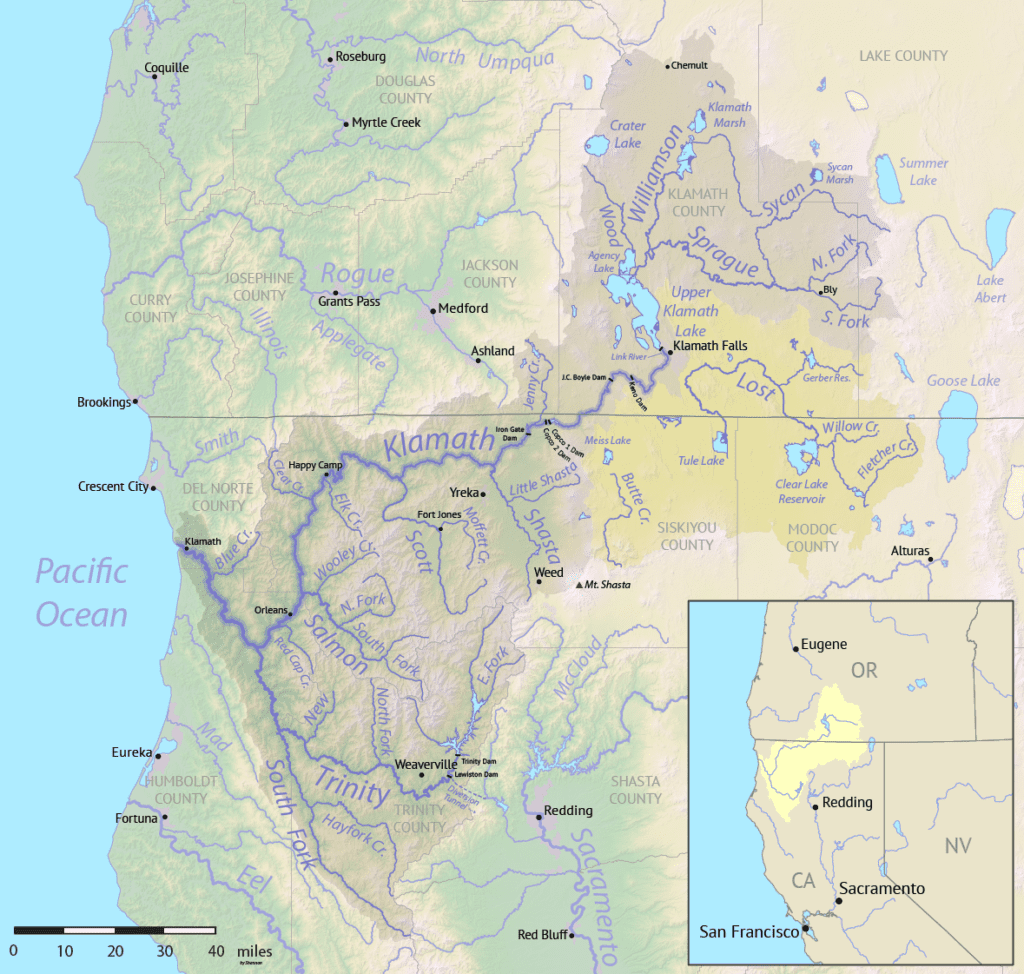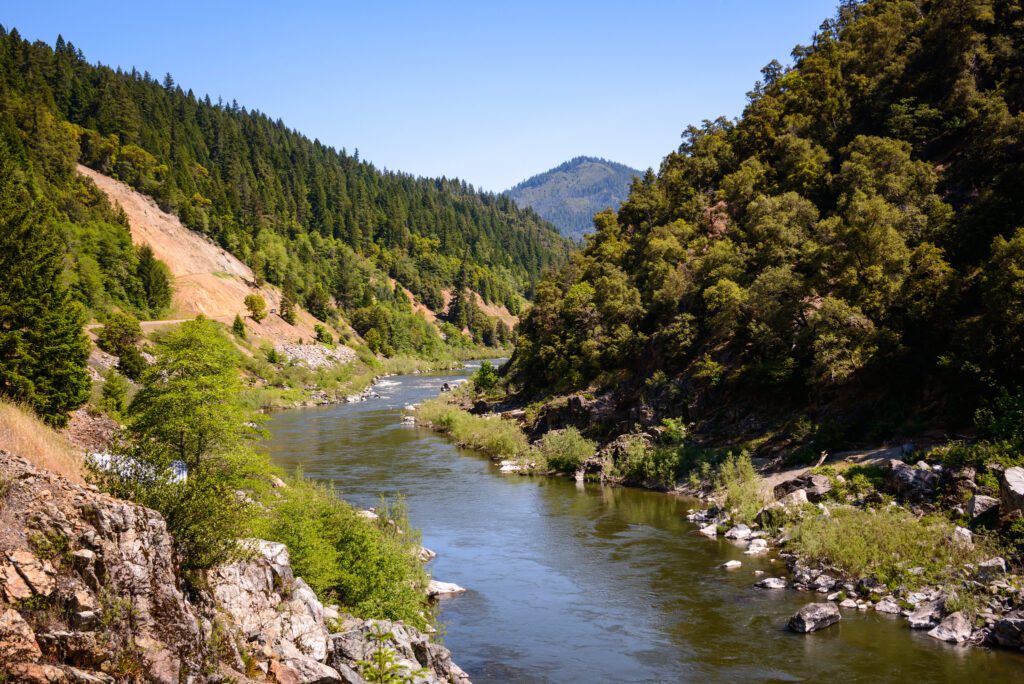Supporting the Health & Healing of the Klamath River Basin
The Klamath River Fund is a program of the Humboldt Area Foundation and the Wild Rivers Community Foundation (HAF+WRCF).
The Klamath River Fund program is focused on community-led climate resilience and restorative justice work. Following the unprecedented dam removal in 2023 and 2024, the Klamath River Fund will invest in and amplify restoration and revitalization efforts in the entire Klamath basin in the decade that follows.
The removal of the dams is the result of generations of work to bring healing to the Klamath River basin. Now we have another generational project ahead of us, restoring the ecosystem so the region can thrive, ecologically, culturally, economically, and beyond.
Klamath Dam Removal Efforts
The Klamath dam removal is the largest dam removal project and largest river restoration project in U.S. history, with monumental impacts for river and ecosystem health, economic and workforce development, revitalization of Tribal and rural communities, and restorative justice to Tribes and Indigenous people who have lived along the river since time immemorial. Led by the Yurok and Karuk Tribes in partnership with nonprofit organizations, lawyers, scientists, and activists, the project will reopen 400 miles of habitat for coho salmon, Chinook salmon, steelhead trout, and other threatened fish species, and allow the lower Klamath River to flow freely for the first time in more than a century.
The 257-mile-long Klamath River was once the third largest salmon-producing river on the U.S. West Coast, and an important source of food for Tribes across the basin. Dams, combined with over-allocation of limited water supplies and climate-driven mega-drought, have contributed to declines in salmon and steelhead abundance. This has impacted Tribal, recreational, and commercial fisheries and the communities and economies they support.
In April, the Pacific Fishery Management Council recommended canceling the 2024 California salmon season due to plummeting Chinook populations. This recommendation mirrors their decision in 2023 when they also advised closing the fisheries. Unfortunately, this closure had significant impacts on Tribes and commercial fishing businesses, resulting in the loss of approximately 23,000 jobs and $1.4 billion in revenue for California.

Klamath River Fund Goals
The Klamath River Fund was established with seed funding from the William and Flora Hewlett Foundation and additional launch funding from the James Irvine Foundation, Roundhouse Foundation, and an anonymous funder. HAF+WRCF is now inviting philanthropic partners that share our goals to join us in this exciting and momentous opportunity.
The Klamath River Fund seeks to accomplish the following goals over the next 10 years (2023-2033):
Create a comprehensive effort to advance climate and community resilience within the Klamath River watershed from the headwaters in Klamath Lake in Oregon to its mouth in Requa, California.
Scope and facilitate effective grantmaking, strategy coordination, and technical assistance to support Tribal and local community-driven restoration and revitalization priorities.
Increase philanthropic and public funding for Tribal and rural community needs in the basin.
Demonstrate how river restoration, of which dam removal is only the first step, is an investment in climate resilience, community resilience, and restorative justice.
Grantee Highlights
Renaissance Tour Highlights Communities Reconnecting Toward a Sustainable Future
On March 13, 2025, the Klamath Drainage District (KDD) hosted the second annual Lower Klamath…
Grantee Profile: Upper Klamath Basin Ag Collaborative
At the headwaters of the Klamath River lies the Sprague River, a vital artery coursing…
Klamath River Fund Announces $1.2 Million in Grants to Support Klamath Basin Restoration and Resilience
Klamath River Fund Announces $1.2 Million in Grants to Support Klamath Basin Restoration and Resilience …
Grants and Sponsorships in Klamath Basin Support Restoration, Cultural Revitalization, Storytelling and More
We’re dedicated to supporting nonprofits, Tribes, and community organizations in the Klamath River Basin with…
Save California Salmon Inspires the Next Generation with Hands-on Engagement
Students from several nearby schools took part in field trips to witness the drawdowns of…
Grantee Spotlight: Grant Supports California Trout’s New Monitoring Project on the Klamath
In July 2024, CalTrout and partners launched the Klamath River Monitoring Program to build our…
First Grants from Klamath River Fund Making an Impact
Photo Courtesy Save California Salmon. We’re excited to announce our first round of grants from…


News & Updates
$1.2 Million in Grants Support Klamath Basin Restoration and Resilience
Paddle Tribal Waters participants on Klamath River. Photo courtesy Paddle Tribal Waters. This spring, the…
Recommended Media: Klamath Renaissance Continues to Unfold in Print, Digital and Beyond
The story of the battle to un-dam the Klamath continues to command coverage in national…
Renaissance Tour Highlights Communities Reconnecting Toward a Sustainable Future
On March 13, 2025, the Klamath Drainage District (KDD) hosted the second annual Lower Klamath…
Grantee Profile: Upper Klamath Basin Ag Collaborative
At the headwaters of the Klamath River lies the Sprague River, a vital artery coursing…
Program Priorities
The program’s first priority is to build and deepen relationships within the Klamath Basin with community leaders, cultural leaders and elected Tribal officials; listen to needs and desires; and co-design strategy and priorities. This will lay a groundwork of understanding around opportunities and community hopes, where strength, power, activities, resources and existing funding currently reside, and where there are gaps. This will allow for strategic planning and program design that is based on community input and accounts for long-term commitment and support.
The program will enhance and strengthen relationships between and among community members and leaders, Tribal Nations, agencies, and philanthropy throughout the Klamath Basin; increase collective narrative and understanding of how restoration is defined, envisioned, and implemented, including individual relationships to the river; and support decision making systems that are respectful, informed, and empower self-efficacy.
The fund will support grantmaking to bolster community healing, Tribal self-determination, science and restoration, storytelling, climate resilience, sustainable agriculture and environmental stewardship and more. In addition, 60 percent of grant funds will support Tribes and/or Indigenous-led and -serving organizations in the basin. Grant funds will also leverage public dollars into the region by funding capacity building, technical assistance, pre-development needs, and/or match dollars.
If philanthropy works together to leverage this moment that Tribes, activists, landowners, agencies and nonprofits have worked toward for decades, restoration of the Klamath River could someday be cited as a premier example of climate resilience and restorative justice on an unprecedented scale. We hope you will join us in this exciting opportunity.
General Inquiries?
For general inquiries, email the Klamath Team or contact:
Holly Hensher, Senior Program Officer hollyh@hafoundation.org
Brianna Juarez, Program Manager briannaj@hafoundation.org
The Klamath Philanthropic Funders Collaborative thanks its current members for their continued support: The William & Flora Hewlett Foundation, The James Irvine Foundation, the Roundhouse Foundation, Meyer Memorial Trust, Tamalpais Trust, the Jubitz Foundation, The California Endowment, the MacArthur Foundation, the Bella Vista Foundation, the Gordon and Betty Moore Foundation, the McConnel Foundation, and an anonymous donor.
